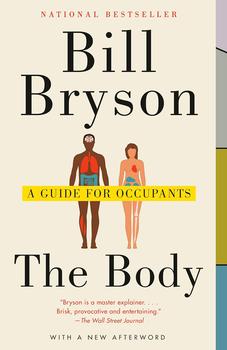Summary | Excerpt | Reviews | Beyond the Book | Readalikes | Genres & Themes | Author Bio

Critics' Opinion:
Readers' Opinion:
First Published:
Oct 2019, 464 pages
Paperback:
Jan 2021, 464 pages
 Book Reviewed by:
Book Reviewed by:
Kim Kovacs
Buy This Book
Keeping every part of the body supplied with sufficient quantities of blood at all times is a tricky business. Every time you stand up, roughly a pint and a half of your blood tries to drain downward, and your body has to somehow overcome the dead pull of gravity. To manage this, your veins contain valves that stop blood from flow-ing backward, and the muscles in your legs act as pumps when they contract, helping blood in the lower body get back to the heart. To contract, however, they need to be in motion. That's why it's important to get up and move around regularly. On the whole, the body manages these challenges pretty well.
"For healthy people there is a less than 20 percent difference between blood pressure at the shoulder and at the ankle," Siobhan Loughna, a lecturer in anatomy at the University of Nottingham Medical School, told me one day. "It's really quite remarkable how the body sorts that out."
As you may gather from this, blood pressure isn't a fixed figure, but changes from one part of the body to another, and across the body as a whole throughout the day. It tends to be highest during the day when we are active (or ought to be active) and to fall at night, reaching its lowest point in the small hours. It has long been known that heart attacks are more common in the dead of night, and some authorities think the nightly change in blood pressure may somehow act as a trigger.
Much of the early research on blood pressure was done in a series of decidedly gruesome experiments on animals conducted by the Reverend Stephen Hales, an Anglican curate of Teddington, Middlesex, near London, in the early eighteenth century. In one experiment, Hales tied down an aged horse and attached a nine-foot-long glass tube to its carotid artery by means of a brass cannula. Then he opened the artery and measured how high blood shot up the tube with each dying pulse. He killed quite a number of helpless creatures in his pursuit of physiological knowledge and was roundly condemned for it—the poet Alexander Pope, who lived locally, was especially vocal on the matter—but among the scientific community his achievements were celebrated. Hales thus had the double distinction of advancing science while at the same time giving it a bad name. Though Hales was denounced by animal lovers, the Royal Society awarded him its very highest honor, the Copley Medal, and for a century or so Hales's book Haemastaticks was the last word on blood pressure in animals and man.
Well into the twentieth century, many medical authorities believed that high blood pressure was a good thing because it indicated vigorous flow. We now know, of course, that chronically elevated blood pressure very seriously raises the risk of a heart attack or stroke. A more difficult question is, What exactly constitutes high blood pres-sure? For a long time, a reading of 140/90 was generally considered the baseline for hypertension, but in 2017 the American Heart Association surprised nearly everyone by abruptly pushing the number downward to 130/80. That small reduction tripled the number of men and doubled the number of women aged forty-five or under who were deemed to have high blood pressure and lifted practically all people over sixty- five into the danger zone. Almost half of all American adults— 103 million people—are on the wrong side of the new blood pressure threshold, up from 72 million previously. At least 50 million Americans, it is thought, are not receiving appropriate medical attention for the condition.
Heart health has been one of the success stories of modern medicine. The death rate from heart diseases has fallen from almost 600 per 100,000 in 1950 to just 168 per 100,000 today. As recently as 2000, it was 257.6 per 100,000. But it is still the leading cause of death. In the United States alone, more than eighty million people suffer from cardiovascular disease, and the cost to the nation of treating heart disease has been put as high as $300 billion a year.
Excerpted from The Body by Bill Bryson. Copyright © 2019 by Bill Bryson. All rights reserved. No part of this excerpt may be reproduced or reprinted without permission in writing from the publisher.





The Funeral Cryer by Wenyan Lu
Debut novelist Wenyan Lu brings us this witty yet profound story about one woman's midlife reawakening in contemporary rural China.
Your guide toexceptional books
BookBrowse seeks out and recommends the best in contemporary fiction and nonfiction—books that not only engage and entertain but also deepen our understanding of ourselves and the world around us.